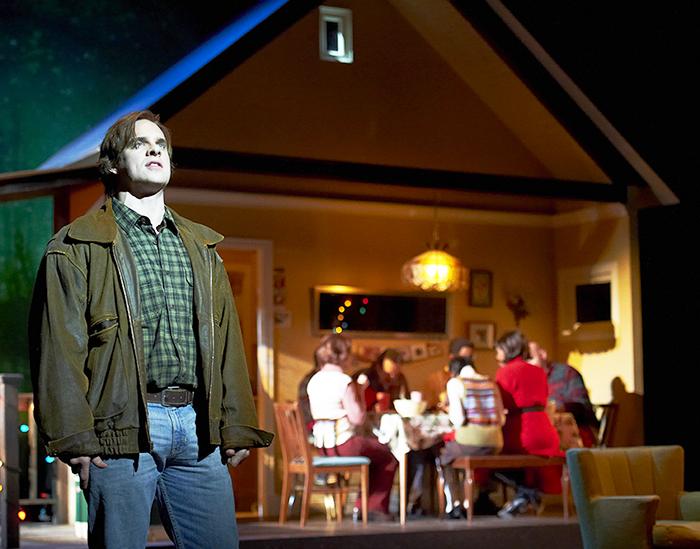Things certainly have changed since Dickens’ time. The miserly scrooge-like main character is now poor and has a family but still cannot feel the Christmas spirit. It’s almost like a peak into the classic Scrooge’s life if he would have proposed to the woman he loved instead of pursuing money; then, Scrooge was miserable because he had no love, in A Carol for Cleveland¸Ed Podolak is miserable because he has no money.
To be sure, Eric Coble’s theater adaption of Les Robert’s novella is more relatable to a Cleveland audience than Dickens’ classic, and not just because of the setting. The story has a particularly Cleveland flavor to it, even though there is still too much rehashing from Dicken’s story to call it innovation. There is a pretty heavy dose of reality to this play, at least in the beginning, which serves as the play’s strong point. Ed Podolak gets the pink slip at his steel mill job in Pennsylvania and finds himself spending a year away from his family as he tries desperately to make ends meet in 1979 Cleveland. But Cleveland isn’t the land of opportunity Ed was hoping for; instead he finds it about as inhospitable as the treacherous black ice he falls on as he steps off the bus. It’s pretty clear that Ed is miserable; sleeping in a grimy hotel, getting no solid jobs that pay reliably and finally, a former colleague from the steel mill comes in and steals money from the hotel’s cash box. These scenes are definitely the best part of the show. The characters convey a sense of world-weariness and cynicism that frankly fits the current economic situation perfectly. It might say something about the later scenes that I would refer to this opening gambit of misery as “fresh.”
The later scenes unfortunately do not continue the trend of innovation seen in the opening and ultimately fall into the passé formula of Everyman Christmas stories. Fortunately, at least, it’s not the fault of the actors who do a superb job of carrying this uplifting bundle of clichés to its inevitable happy end. Rather, it seems to be a problem with the script. Aside from outright banal dialogue which ceased to hold my interest either with wit or gravity after the half-hour mark, the story just becomes progressively less believable. Ed struggles on and, in his desperation, steals $94 from a drunken street corner Santa only to be observed by the “Tiny Tim” of this story, a strangely “wise for his years” little boy with a limp named Charlie. At this point we are introduced to the impoverished “Cratchets” of the story. Somehow, despite being out of a job, they manage to stick together and share the spirit of Christmas, (never mind the fact that in all likelihood that, in a year, they will all look like Ed). I think it’s no spoiler to say the play has a happy ending since it is, after all, a Christmas play. However, the manner in which these scenes were written, took the emotional punch out of the moral lessons that Ed learns throughout the play.
There was one other aspect of this play which I found particularly irritating was the manner in which Cleveland was presented. This speaks further to the problems with the writing and the issue of a sloppily handled mix of real and surreal. In the beginning, Cleveland is presented as bitterly cold and not particularly welcoming. It’s an atmosphere which persists throughout the play, an atmosphere of struggle and economic difficulties in the post-steel boom years. I found nothing wrong with this. However, then the narrator would say “the magic of driving down Carnegie.” I can assure him that of the probably thousands of times I have traveled down Carnegie I have felt no magic although my car doors do “magically” lock themselves as I head East. Such instances throughout the play speak to a greater identity crisis in Cleveland, perhaps brought on by being directly in between New York and Chicago yet being neither New York nor Chicago. We are either hard men in a city of struggle or we have magic streets. I vote for the former.
On the other hand, I have to say something good about the sets. They are truly spectacular. The sights and sounds of Cleveland like Public Square and the Sell Mills are really brought on stage. What really impressed me, however, were the scene transitions. It seems like such a little thing but it makes a huge difference for the audience. Normally, scene changes break the action and remind you just how long you’ve been sitting in the theater (or how long you have yet to sit in the theater). In A Carol for Cleveand this doesn’t happen because the transitions are done so smoothly that there is no perceptible break. It could be accurately described as a dream in which one part flows directly into another, almost without knowing how the change occurred.
Ultimately, A Carol for Cleveland is nothing terribly new. It’s a really a “Cleveland take” on the Christmas Carol which despite a not-very-inspiring script, is acted and executed well. If you are looking for art or something thought-provoking or even a really interesting twist on a Christmas narrative, look elsewhere. If you are looking for a Christmas story that mindlessly reminds you to be in the holiday spirit despite economic difficulties and does so with a beautiful set and good acting, then you will probably enjoy this play.


